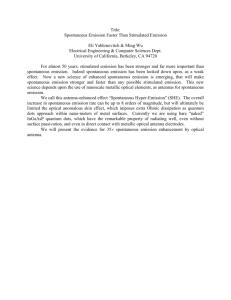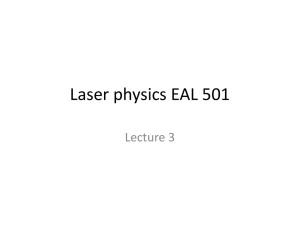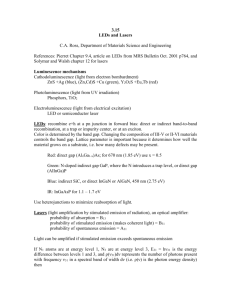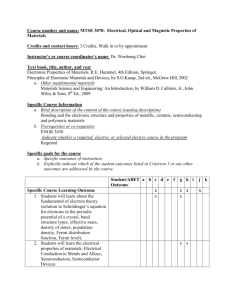Lecture Slides
advertisement
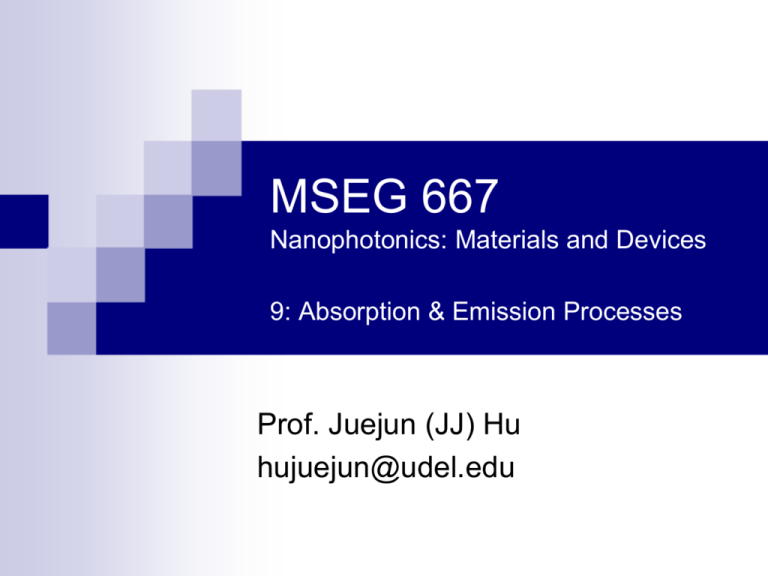
MSEG 667 Nanophotonics: Materials and Devices 9: Absorption & Emission Processes Prof. Juejun (JJ) Hu hujuejun@udel.edu Optical absorption in semiconductors Band structure of silicon G : kx k y kz 0 L : kx 2 , k y kz 0 a X : kx k y kz a = 5.43 Å a Band structure of semiconductors near band edge E E Eg Eg k Direct gap semiconductors: compound semiconductors k Indirect gap semiconductors: group IV semiconductors Energy and crystal momentum conservation E Energy conservation EC kC EV kV Crystal momentum conservation kC kV kC kV ~ ke k Thermalised electron momentum kC ~ 1 3 2m kBT ~ 2.2 108 m1 2 * e Photon momentum n ~ 107 m 1 kC c Energy and crystal momentum conservation E 2 kC 2 EC kC EC 2me* EC 2 kV 2 EV kV EV 2mh* k EV Parabolic band approximation Energy conservation EC ke EV ke 2 2 2 ke 2 ke EC EV Eg 2mr 2mr Reduced mass: mr 1 m 1 m * e * h 1 Energy and crystal momentum conservation E 2 ke 2 Eg 2mr 1 ke 2mr Eg EC k EV Energy conservation EC kC EC EV kV EV Eg 1 me* mh* Eg 1 mh* me* For a given photon energy, only a narrow band of states contribute to absorption! Electronic density of states in energy bands Number of states with energy between E to E dE V dE 4 3 In the k-space each electronic state occupies a volume of V E where V is the volume of the system 2 ke 2 EC ke EC 2me* Dispersion relation dkC 4 kC 2 dkC kC 2 dkC C EC C kC 2 3 VdE 4 V VdE dE C E 1 2 3 m * e 32 2 E EC Beware of spin degeneracy! Absorption in direct gap semiconductors Photon absorption rate is proportional to the joint density of states: the density of states (pairs) that can participate in the absorption process 2 ke 2 EC ke EV ke Eg 2mr j E j j dke ke 2 dke ke 2 VdE 2 dE mr 3 2 1 2 3 2 E g 2 Eg Optical transition typically does not flip the electron spin state Direct band gap energy determination 1 Eg Eg 2 V. Mudavakkat et al., Opt. Mater. 34, Issue 5, 893-900 (2012). Absorption in indirect gap semiconductors Conservation laws EC kC EV kV q EC kC EV kV kC kV kq E q k Typical optical phonon energy in Si: 60 meV Absorption in indirect gap semiconductors Phonon-assisted absorption: 1 E g q 2 exp q k BT 1 12 Eg Indirect band gap energy determination Si Appl. Opt. 27, 3777-3779 (1988). Nanotechnology 23, 075601 (2012). Amorphous solids Short range order (SRO) Lack of long range order (LRO) Properties pertaining to SRO: Energy band formation Density of states Properties pertaining to lack of LRO: Crystal momentum (not a good quantum number anymore!) Localized states (Anderson localization) Amorphous Random Unlike gases, amorphous solids are NOT completely random vs. Mobility gap in amorphous solids Mobility edge: a well-defined energy that separates extended states with localized states Tauc gap and Tauc plots Tauc gap ET definition: ET It is merely a fitting parameter and has little physical significance! 12 ET = 3.3 eV Quasi-Fermi levels in non-equilibrium semiconductors Optical or electrical injection increases the density of both types of carriers In semiconductors displaced from equilibrium, separate quasi-Fermi levels, EFn and EFp must be used for electrons and holes, respectively (EFn = EFp in equilibrium) Quasi-thermal equilibrium within bands: electron relaxation time within a band is much lower than across the band gap Occupation probability in the conduction band: fC E 1 1 exp E EFn k BT Occupation probability in the valence band: fV E 1 1 exp E EFp k BT Absorption saturation effect At high injection levels, the available empty states for electrons in the conduction band are depleted E E Equilibrium Pumping k High injection level k Absorption saturation effect E E Pumping k Equilibrium High injection level Absorption coefficient in the presence of saturation: j fV EV 1 fC EC Here EC and EV are the energies of the initial and end states k Stimulated emission The reverse process of optical absorption Electron-hole recombination to emit a photon in the presence of an external electromagnetic field excitation Energy conservation EC kC EV kV where is the angular frequency of the external field as well as the emitted photon Optical gain s j f C EC 1 fV EV E k Net gain and optical amplification Net gain = gain – loss g s 1 j f C EC fV EV g 0 fC EC fV EV EFn EFp In practical applications, additional loss sources (scattering, FCA, etc.) need to be considered in the loss term as well L. A. Coldren and S. W. Corzine, Diode Lasers and Photonic Integrated Circuits Population inversion Stimulated and spontaneous emission Stimulated emission Spontaneous emission Single mode rate equation Consider a semiconductor with uniform carrier density n : carrier density n Rabs Rstim Rsp t np : photon number No carrier injection Rabs kabs n p fV EV 1 f C EC Absorption rate Rstim k stim n p f C EC 1 fV EV Stimulated emission rate Rsp ksp fC EC 1 fV EV Spontaneous emission rate kabs , kstim , ksp : absorption, stimulated and spontaneous emission coefficients, which are environment-independent Single mode blackbody radiator In thermal equilibrium fC EC 1 1 exp EC EF k BT 1 fV EV 1 exp EV EF k BT np exp 1 kBT 1 Fermi-Dirac distribution Planck distribution Energy conservation: EC EV Hot blackbody ( Cool blackbody ( k BT ): n p k BT k BT ): n p 0 1 Single mode “hot” blackbody radiator In thermal equilibrium np k BT 1 Rabs , Rstim k BT Rsp Absorption and stimulated emission dominate over spontaneous emission in a “hot” blackbody n Rabs Rstim 0 Rabs Rstim t Thermal equilibrium fC EC 1 fV EV exp EV EF k BT kabs 1 kstim 1 fC EC fV EV exp EC EF k BT At high temperatures, occupation probability of all states are equal kabs kstim Single mode “cool” blackbody radiator In thermal equilibrium n Rabs Rstim Rsp 0 t ksp kabs n p ksp kabs fV EV 1 fV EV 1 f C EC f C EC Rereading Einstein on Radiation k stim n p exp EC EF k BT np 1 n p exp k BT 1 1 exp EV EF k BT ka e kabs k stim k sp All the rate constants are the same specified by detailed balance Note: the rate constant ka-e is NOT a material constant as it depends on the optical mode under investigation Optical gain in semiconductors The absorption curve at zero injection level and the gain curve at complete inversion are symmetric with respect to the horizontal axis Their shape reflects the joint DOS in the material d Optical amplification Under steady-state carrier injection: n r t Optical injection Gain medium I 0 e G gd Rabs Rstim Rsp Rnr G 2 J n 0 Net radiative recombination I0 Non-radiative recombination Current injection Optical amplification: n p z g G gn p n p t vg G gn p Rstim Rabs vg G gn p Rstim Rabs ka e fC EC fV EV G vg n p G vg g 1 j fC EC fV EV ka e G j Carrier density in semiconductor devices Solving the current continuity and the Poisson equations n r t Rabs Rstim Rsp Rnr G 2 J n 0 D f D E E f e n p N A ND 2 0 V bias Current continuity Poisson equation 0.5 V forward bias 1-D semiconductor device simulator: SimWindows download Stimulated emission and spontaneous emission in technical applications Stimulated emission Optical amplifiers Lasers Spontaneous emission LEDs Fluorescence imaging Photoluminescence spectroscopy Laser threshold Threshold Below threshold Spontaneous emission into multiple cavity modes dominates Gain < loss Incoherent output Current (I) Above threshold Stimulated emission into usually a single mode dominates Gain ~ loss Coherent output × 100 Wavelength (l) Current (I) Wavelength (l) Engineering spontaneous emission rate: Purcell effect Fermi’s golden rule: G 2 2 f V i ( E f Ei ) all final states f Initial state i electron in CB + 0 photon No photon states: suppressed spontaneous emission (SE) Photonic band gap Large photon density of states: enhanced (i.e. faster) SE rate Final state f electron in VB + 1 photon Optical resonant cavity Enhancement factor (Purcell factor) of SE in a cavity: l Q FP 4 2 n V 3 3 n : refractive index Q: cavity Q-factor* l : wavelength V: cavity mode volume Engineering spontaneous emission rate: Purcell effect SE suppression SE enhancement "Investigation of spontaneous emission from quantum dots embedded in twodimensional photonic-crystal slab," Electron. Lett. 41, 1402-1403 (2005).

